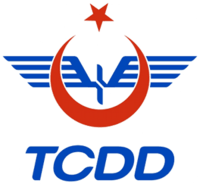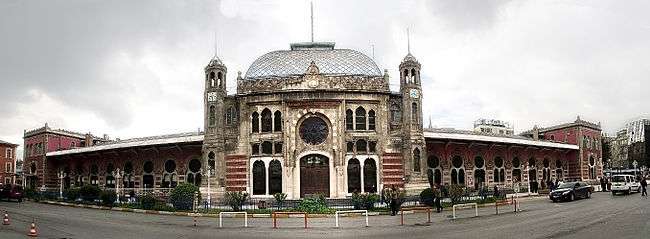TCDD Taşımacılık
 | |
| Government-owned (100%) | |
| Industry | Railway transport, logistics |
| Founded | 2016 |
| Headquarters | Ankara, Turkey |
Key people | Veysi Kurt (Chairman) |
| Revenue |
|
|
| |
|
| |
| Owner | Republic of Turkey |
Number of employees |
|
| Website | TCDD Taşımacılık |
TCDD Taşımacılık A.Ş. is a government-owned company formed to operate passenger and freight trains throughout Turkey, using infrastructure owned by the Turkish State Railways. The company was formed in 2016 as part of the restructuring of the Turkish railways. The company is headuqarted in Ankara and Veysi Kurt is the first and current CEO.
Passenger operations
The Turkish State Railways operate passenger services on 90% of their system. These are intercity, regional, commuter and international services. In the railways first year 52% of passenger travel in Turkey was by rail, despite the system lacking connections to many parts of the country. Rail transport was the main mode of transport for passengers in the following two decades, reaching an all-time high of 57% of passenger transport in 1947, but then started to decline after 1950, due to the mass construction of roads.[3] Today, the passenger ratio is slowly increasing with the opening of high-speed rail lines in Turkey.
In 2013, almost 21 million of people traveled by train in Turkey. 16.7 million on main lines, 4.2 million on high speed lines (25% increase compared to 2012). The share of railway in domestic travels is about 2.2%.[4]
The types of passenger service are:
- High-speed (Hızlı Tren): High-speed rail services and TCDD's premier service.
- Mainline (Anahat): Intercity trains operating between major cities.
- International (Uluslararası): Trains operating on international routes, toward Europe or the Middle East.
- Regional (Bölgesel): Trains operating within their respective districts.
- Commuter (Banliyö): Commuter trains, currently operating in Ankara and İstanbul.
High-speed services

High-speed rail in Turkey began service in 2009. TCDD has branded its high-speed service as Yüksek Hızlı Tren or YHT. YHT currently operates on two lines: the Ankara–Istanbul high-speed railway and the Ankara–Konya high-speed railway.
On 13 March 2009, the first phase of the Ankara–Istanbul high-speed railway entered service between Ankara and Eskişehir. The YHT service between Ankara and the Pendik railway station in Istanbul's Asian side began on 27 July 2014.[5] The train has 6 daily departures in both directions.[6] On 23 August 2011, the YHT service on the Ankara–Konya high-speed railway was inaugurated.
The rolling stock used for the YHT service are the Spanish-built HT65000 and German-built HT80000 EMUs. These trains operate at speeds of 120 km/h within urban areas, but can reach speeds of up to 250 km/h (HT65000)[7] or 300 km/h (HT80000)[8] on the dedicated high-speed lines outside urban areas. The HT65000 EMUs have 6 permanently coupled cars, with 4 economy class cars, 1 café car and 1 business class car. Economy class has 2+2 seating with power outlets, fold-able tables and private radio. There is a lavatory at one end of the car. The business class car has 2+1 seating, with power outlets, greater leg room, private radio, fold-able tables and steward service as well as LCD TVs in front of every seat.[9]
High-speed rail in Turkey is still developing, with two lines under construction and many more planned. Once the line to İstanbul is completed, travel between Ankara and İstanbul will drop to 3 and a half hours, compared to 5 hours by car. By 2023, the Ministry of Transport expects Turkey's high-speed rail system to increase to 10,000 kilometers.[10]
Mainline services
Mainline service (Turkish: Anahat) is the railway's main service. In 2010 mainline services made up for 24% of the railways passenger traffic.[11] Mainline service includes 3 types of trains: Express, Blue Train and Passenger.
Express service is between major cities and are fast, comfortable and equipped with modern air conditioned TVS2000 railcars and only stop at important stations. Express trains have an average operating speed of 100 km/h (62 mph) to 120 km/h (75 mph). The most express service is between İstanbul and Eskişehir with 8 trains daily in each direction. Express service also has overnight trains between major cities far apart (e.g. İstanbul-Kars). These trains have coaches, a dining car and a sleeping car or a couchette car or sometimes both.
Blue Train service was the State Railways' premier express service, starting in 1979 between İstanbul and Ankara, with a blue DE24000 locomotive and custom built blue railcars. Today, the Blue Train service has become a part of the mainline service and uses the same TVS2000 rolling stock. Currently, there are four Blue Trains in service; operating on the Ankara-İzmir, İstanbul-Adana, Ankara-Adana and Ankara-Malatya lines. All these trains are overnight trains. The İstanbul-Ankara Blue Train service was cancelled in 2000.
Passenger class service is the slowest mainline service, making local stops but not as many as regional service. Passenger service use mainly modernized intercity railcars and occasionally TVS2000 railcars. Passenger class trains used to run on more lines but today the only passenger class service is the Bosphorus Express.
The TVS2000 railcars used on mainline service are the most comfortable cars in TCDD's entire fleet. TVS2000 railcars may also be used on International service because international services are considered mainline services within Turkey.
International services
International services to Europe

The TCDD operates two international services to Europe, from Istanbul: The Bosfor Ekspres (Bosphorus Express) to Bucharest and the Balkan Express to Sofia and Belgrade (which splits from the Bosfor Ekspres).
- Bosphorus Express, to Bucharest, Romania via Edirne, Dimitrovgrad, Stara Zagora and Russe. It has been run from Halkalı due to Marmaray project since 1 March 2013.
- Balkans Express, to Belgrade, Serbia via Edirne, Dimitrovgrad, Plovdiv, Sofia and Nis
TCDD also connects with Greek trains from Pythio to Thessaloniki: the IC 90 / 91.[note 1][12]
International services to the Middle East and Asia

The Haydarpaşa Terminal is the terminus for a weekly train to Tehran in Iran, another train to Iran travels between Van, Turkey and Tebriz in Iran.[13]
Additionally, trains from Iran to Syria (and vice versa) pass through Turkey.[13]
- Trans-Asia Express, to Tehran, Iran via İzmit, Bilecik, Eskişehir, Ankara, Kayseri, Sivas, Elazığ, Tatvan (train-ferry), Van and Tabriz
- Van-Tebriz Treni (Van – Tabriz train) Route: Van, Özalp, Kapıköy, Razi, border crossing to Iran, Salmas, Tabriz (and back.)
Former international services
- Tehran – Damascus train Route: Tehran, Tabriz, Razi, Kapıköy, border crossing to Turkey, Van, (train-ferry), Tatvan, Muş, Elazığ, Malatya, Fevzipaşa, Islahiye, Meydanekbez, Turkey – border crossing to Syria, (via Chemins de Fer Syriens) – Meidan Ekbis, Aleppo, Damascus (and back.) This service was interrupted when the border between Syria and Turkey was closed due to the Syrian civil war.[14]
- Taurus Express (Toros Ekspresi), Route: Istanbul: Haydarpaşa Terminal, Eskişehir (Enveriye), Kütahya, Afyon, Konya, Adana, Fevzipaşa, Islahiye, Meydanekbez, border crossing to Syria (via Chemins de Fer Syriens) – Aleppo, Damascus (and back.)[note 2]
- Gaziantep – Baghdad (temporarily suspended since 13 March 2003), Route: Turkey: Gaziantep, Karkamış, Akçakale, Ceylanpınar, Şenyurt, Nusaybin, border crossing to Syria, Al Qamishli, (via Chemins de Fer Syriens), border crossing to Iraq, El-Yaribieh, Rabia, Mosul, Baghdad. It was also running from Istanbul to Gaziantep as mainline until 2003. It is begun again on 16 August 2012 between Eskişehir-Adana[15] but due to renovations, it's shortened to Konya-Adana route on 15 March 2013.[16]
- Dostluk/Fillia Express (IC 90/91), to Thessaloniki, Greece via Uzunköprü, Pythio and Alexandroupolis. It was terminated in February 2011 due to the economic crisis in Greece.
Freight operations
Rail freight transport
From 1980 onwards, rail freight tonne-kilometers transported by the TCDD rose slightly from ~5000million tonne-km in 1980 to ~7000million tonne-km in 1990 and to ~9000million tonne-km in 2000.[17] Approximately 50% of freight moved is minerals or ores, with construction materials increasing to ~10% in 2000 from less than 5% in 1980, food/agricultural products, chemicals/petroleum, and metal sectors each account for between 5 and 10%. International freight accounted for approximately 5% of totals in 2000.[17]
As of 2012, 25.7 million ton is transported by rail in Turkey. Two steel companies, Erdemir and Kardemir, top 2 customers of TCDD, had transported 4.5 million ton in 2012, mainly iron ore and coal.[18] 2.1 million tons of rail freight belong to international traffic. Most of international traffic is between Turkey and Europe, done via Kapikule. Several container trains are running in this route as well as conventional wagons.[19]
As of 2014, 26.6 million ton is transported on rail in Turkey. 7.1 million of it is done by private wagons. International transport went down to 1.7 million.[20]
Containers are widely used both in international and domestic transportation. 7.6 million ton is carried in containers. TCDD is supporting transportation by containers. Thus almost all of the private railway companies invested in container wagons, and carrying 20% of all rail freight by their own wagons.[21]
TCDD has plans to strengthen freight traffic by adding 4000 km conventional lines until 2023. That includes new international rail connections to Georgia, Iraq and Iran.[22] TCDD is also constructing 18 logistic centers to enable transportation of more loads by rail.[23]
TCDD is planning to increase its transit traffic (11000 to in 2011) by constructing "iron silk road" to connect Europe to Asia. Marmaray is the most important part of this project which was completed in 2015 and now in service.[24] Another project is Kars–Tbilisi–Baku railway which is planned to be completed in 2016 and start functioning in 2017.[25] Also, plans for another supplying project to Kars-Tbilisi-Baku railway, the Kars-Igdir-Nakhcivan high speed railway has been completed.[26] TCDD wants to have share from the freight traffic between Europe and China through this line.[27]
References
- 1 2 3 Annual Statistics of the Turkish State Railways, T.C.D.D., available at http://www.tcdd.gov.tr/files/istatistik/20102014yillik.pdf
- ↑ Annual Sector Report of the Turkish State Railways, T.C.D.D., available at http://www.tcdd.gov.tr/files/istatistik/2014sektorrapor.pdf
- ↑ TCDD ratios 1922–2005
- ↑ Uysal, Onur. "Turkish Railway Industry Report 2013 – Passenger", Rail Turkey, 24 July 2014
- ↑ Uysal, Onur. "First High Speed Train Set on Ankara Istanbul Line Arrived Istanbul", Rail Turkey, 26 July 2014
- ↑ Uysal, Onur. "New Schedule for Istanbul-Ankara High Speed Train", Rail Turkey, 9 August 2014
- ↑ "Technical specifications of TCDD HT65000". CAF. Retrieved 15 July 2016.
- ↑ "Velaro Turkey High-Speed Train" (PDF). Mobility.siemens.com. Retrieved 2015-06-20.
- ↑ YHT Reference Book, Everything about the YHT – Page 41
- ↑ Turkey's high-speed rail system will be complete by 2023 – rayturk.net
- ↑ 2010 TCDD Statistics – tcdd.gov.tr
- ↑ TCDD: Destinations in Europe www.tcdd.gov.tr
- 1 2 TCDD: Destinations in the Middle East
- ↑ "Turkey Closes Syria Border Crossings". The Wall Street Journal. 25 July 2012. Retrieved 2 April 2016.
- ↑ "Vagonları yenilenen "Toros Ekspresi" 16 Ağustos'da seferlerine başlıyor". www.rayhaber.com. Retrieved 2 April 2016.
- ↑ "Toros Ekspresi seferleri iptal edildi". www.rayhaber.com. Retrieved 2 April 2016.
- 1 2 Restructuring options for reform of TCDD, World Bank report 2003, hwtsk.com
- ↑ Uysal, Onur. "Leading Railway Clients 2012", Rail Turkey, 16 December 2013
- ↑ Uysal, Onur. "Leading Railway Companies In Turkey 2012 – European Traffic", Rail Turkey, 14 June 2014
- ↑ Uysal, Onur. "TCDD Annual Statistics 2013", Rail Turkey, 23 October 2014
- ↑ Uysal, Onur. "Leading Railway Companies In Turkey 2012 – Railcar Owners", Rail Turkey, 15 July 2013
- ↑ Uysal, Onur. "2023 Targets in Rail Freight – Network", Rail Turkey, 11 July 2013
- ↑ Uysal, Onur. "2023 Targets in Rail Freight – Logistic Centers", Rail Turkey, 5 December 2013
- ↑ Uysal, Onur. "When Asia and Europe Will Be Connected?", Rail Turkey, 10 December 2013
- ↑ Uysal, Onur. "10 Things to Know About Baku-Tbilisi-Kars Railway Project", Rail Turkey, 20 October 2014
- ↑ Kars-Iğdır-Nahçivan Hızlı Tren Projesi (KIN)
- ↑ Uysal, Onur. "Is Marmaray Key for Europe-Asia Rail Connection?", Rail Turkey, 12 November 2013